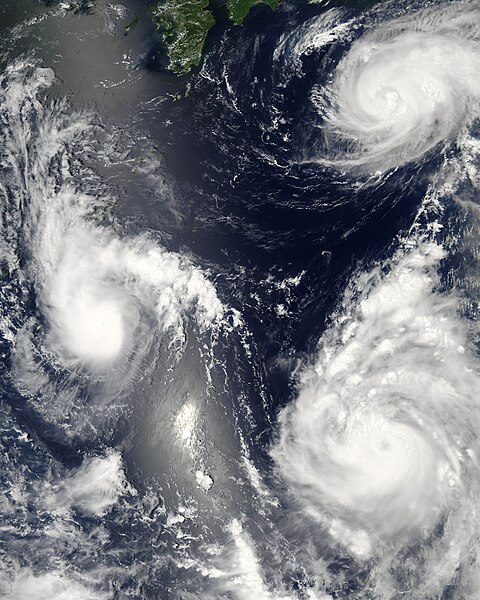Fil:Maria, Bopha and Saomai 2006-08-07 0435Z.jpg

Størrelse på denne forhåndsvisningen: 480 × 600 piksler. Andre oppløsninger: 192 × 240 piksler | 384 × 480 piksler | 614 × 768 piksler | 819 × 1 024 piksler | 1 638 × 2 048 piksler | 7 200 × 9 000 piksler.
Opprinnelig fil (7 200 × 9 000 piksler, filstørrelse: 7,6 MB, MIME-type: image/jpeg)
Filhistorikk
Klikk på et tidspunkt for å vise filen slik den var på det tidspunktet.
| Dato/klokkeslett | Miniatyrbilde | Dimensjoner | Bruker | Kommentar | |
|---|---|---|---|---|---|
| nåværende | 8. aug. 2006 kl. 05:06 |  | 7 200 × 9 000 (7,6 MB) | Good kitty | == Summary == {{Information |Description=Three different typhoons were spinning over the western Pacific Ocean on August 7, 2006, when the Moderate Resolution Imaging Spectroradiometer (MODIS) on NASA’s Aqua satellite acquired this image. The strongest |
Filbruk
Den følgende siden bruker denne filen:
Global filbruk
Følgende andre wikier bruker denne filen:
- Bruk i ar.wikipedia.org
- Bruk i az.wikipedia.org
- Bruk i bg.wikipedia.org
- Bruk i bh.wikipedia.org
- Bruk i crh.wikipedia.org
- Bruk i cs.wikipedia.org
- Bruk i de.wikipedia.org
- Bruk i en.wikipedia.org
- Typhoon
- Typhoon Saomai
- Tropical cyclone
- Wikipedia:Picture peer review/Archives/Archive2006
- User:Plasticup/MyFavorites
- Typhoon Maria (2006)
- User talk:Hurricanehink/Archive 23
- User talk:Thegreatdr/2012archive
- Wikipedia:Wikipedia Signpost/2013-11-20/Traffic report
- Wikipedia:Wikipedia Signpost/Single/2013-11-20
- Wikipedia:Top 25 Report/November 10 to 16, 2013
- User:Tfmbty/2006 Pacific typhoon season
- User:SongdaTalas/Archives of Former Articles
- Bruk i en.wiktionary.org
- Bruk i es.wikipedia.org
- Bruk i fi.wikipedia.org
- Bruk i hi.wikipedia.org
- Bruk i id.wiktionary.org
- Bruk i incubator.wikimedia.org
- Bruk i ja.wikipedia.org
- Bruk i ja.wikibooks.org
- Bruk i ko.wikipedia.org
- Bruk i lo.wikipedia.org
- Bruk i ms.wikipedia.org
- Bruk i my.wikipedia.org
- Bruk i nn.wikipedia.org
- Bruk i pt.wikipedia.org
- Bruk i ro.wikipedia.org
- Bruk i ru.wikipedia.org
- Bruk i szy.wikipedia.org
- Bruk i th.wikipedia.org
- Bruk i tk.wikipedia.org
- Bruk i tr.wikipedia.org
Vis mer global bruk av denne filen.




